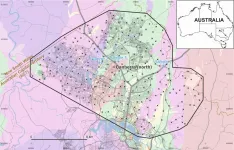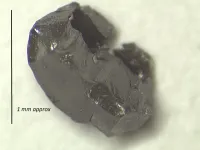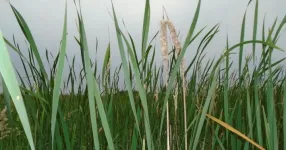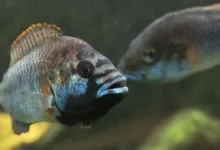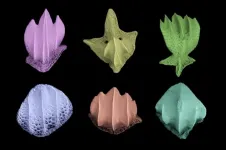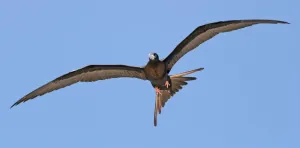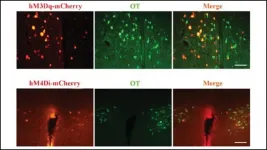(Press-News.org) Scientists have taken the first steps in developing a new method of identifying the movements of criminals using chemical analysis of soil and dust found on equipment, clothing and cars. The locating system allows police or security services to match soil remnants found on personal items to regional soil samples, to either implicate or eliminate presence at a crime scene. The work is presented as a Keynote Lecture at the Goldschmidt Geochemistry Conference, after recent publication.
Dr Patrice de Caritat, Principal Research Scientist at Geoscience Australia, Australia's public sector geoscience organisation, said:
"We've done the first trials to see if geochemical analysis could narrow down a search area. We took a 260 km2 area of North Canberra and divided it into cells (squares) of 1 km x 1 km, and sampled the soil in each cell. We were then given 3 samples from within the survey area, and asked to identify which grid cells they came from. This was a 'blind' experiment, in other words we did not know where the samples came from until the end of the experiment. For comparison, Manhattan Island is around 60 km2, so that shows that we looked at a pretty big area".
Using these methods, they were able to eliminate 60% of the territory under investigation.
Dr de Caritat said "Much of forensics is about elimination, so being able to rule out 60% of an area is a substantial contribution toward successfully locating a sample. You can reduce the time, risk and investment of the ongoing investigation. The more parameters we look at, the more accurate the system is. We have reached 90% detection in some cases, although we think that would involve too many factors for real-world crime detection".
The team used a range of analytical instrumentation - Fourier Transform InfraRed Spectroscopy, X-Ray Fluorescence, Magnetic Susceptibility and Mass Spectrometry to compare the 3 blind samples to the previously collected samples.
Dr de Caritat, who is also Adjunct Professor at the National Centre for Forensic Studies at the University of Canberra, said:
"This shows that our systems work, and that we have a potential new tool for criminal and intelligence investigations. It's the next stage which is potentially most interesting. Most developed countries have existing soil databases*, used for such things as mineral exploration or land use decision support. We're plugging our methods into these databases to see if we can locate samples from the database information, rather than needing to collect samples specifically for each investigation.
Conventional soil analysis has already been used in Australia to identify and prosecute criminals. For example, soil analysis was used to identify the movements of a man who carried out a sexual assault on a young girl in Adelaide. There are several such examples. We now want to take this further".
Dr de Caritat worked with the Australian Federal Police in 2017-18, where he helped them develop their capability to analyse soils for forensic location. He said:
"Geoscience Australia is now working with the Australian Federal Police, the University of Adelaide, Flinders University and the University of Canberra on a Defence Department project to incorporate environmental DNA (e.g. from local plants) and X-Ray Diffraction mineralogy into the soil and dust location system**".
Commenting, Professor Jennifer McKinley (Queen's University, Belfast) said 'The breakthrough in Dr de Caritat's work is that it integrates robust compositional data analysis of the multivariate geochemical data into forensic geoscience and applies this in an innovative way to forensic soil provenance'.
INFORMATION:
This is an independent comment; Prof McKinley was not involved in this work.
Notes
*See examples of soil databases at https://www.appliedgeochemists.org/resources/geochemical-atlases
** See press notification at https://www.defenceconnect.com.au/key-enablers/7235-flinders-uni-research-to-help-combat-terrorism
Publication details
CARITAT, P. de, SIMPSON, T. & WOODS, B., 2019. Predictive Soil Provenancing (PSP): an innovative forensic soil provenance analysis tool. Journal of Forensic Science, 64: 1359-1369. DOI: 10.1111/1556-4029.14060
CARITAT, P. de, WOODS, B., SIMPSON, T., NICHOLS, C., HOOGENBOOM, L., ILHEO, A., ABERLE, M.G. & HOOGEWERFF, J., 2021. Forensic soil provenancing in an urban/suburban setting: a sequential multivariate approach. Journal of Forensic Sciences, online May 2021. DOI: 10.1111/1556-4029.14727
A unique study of ancient diamonds has shown that the basic chemical composition of the Earth's atmosphere which makes it suitable for life's explosion of diversity was laid down at least 2.7 billion years ago. Volatile gases conserved in diamonds found in ancient rocks were present in similar proportions to those found in today's mantle, which in turn indicates that there has been no fundamental change in the proportions of volatiles in the atmosphere over the last few billion years. This shows that one of the basic conditions necessary to support life, the presence of life-giving elements in sufficient quantity, appeared soon after Earth formed, and has remained fairly constant ever since.
Presenting the work at the Goldschmidt ...
Below please find summaries of new articles that will be published in the next issue of Annals of Internal Medicine. The summaries are not intended to substitute for the full articles as a source of information. This information is under strict embargo and by taking it into possession, media representatives are committing to the terms of the embargo not only on their own behalf, but also on behalf of the organization they represent.
1. Infusion centers associated with substantially better outcomes than the ER for patients with acute pain events and sickle cell disease
Abstract: https://www.acpjournals.org/doi/10.7326/M20-7171
Editorial: https://www.acpjournals.org/doi/10.7326/M21-2650
Summary: ...
LAWRENCE -- A new paper from a lead author based at the University of Kansas finds wetlands constructed along waterways are the most cost-effective way to reduce nitrate and sediment loads in large streams and rivers. Rather than focusing on individual farms, the research suggests conservation efforts using wetlands should be implemented at the watershed scale.
The paper, just published in the Proceedings of the National Academy of Sciences, relied on computer modeling to examine the Le Sueur River Basin in southern Minnesota, a watershed subject to runoff from intense agricultural production of corn and soybeans -- crops characteristic of the entire ...
In the movie "A Fish Called Wanda", the villain Otto effortlessly gobbles up all the occupants of Ken`s fish tank. Reality, however, is more daunting. At least one unfortunate fan who re-enacted this scene was hospitalized with a fish stuck in the throat. At the same time this also was a painful lesson in ichthyology (the scientific study of fishes), namely that the defense of some fishes consists of needle-sharp fin spines.
Two types of fin elements
Indeed, many fish species possess two types of fin elements, "ordinary" soft fin rays, which are blunt and flexible and primarily serve locomotion, and fin spines, which are sharp and heavily ossified. As fin spines serve the ...
For 400 million years, shark-like fishes have prowled the oceans as predators, but now humans kill 100 million sharks per year, radically disrupting ocean food chains. Based on microscopic shark scales found on fossil- and modern coral reefs in Caribbean Panama, Smithsonian scientists reveal the changing roles of sharks during the last 7000 years, both before and after sharks in this region were hunted. They hope this new use for dermal denticles will provide context for innovative reef conservation strategies.
Microscopic scales covering a shark's body--dermal ...
A study published the week of July 5 in the Proceedings of the National Academy of Sciences led by Michael Moore at Washington University in St. Louis finds that dragonfly males have consistently evolved less breeding coloration in regions with hotter climates.
"Our study shows that the wing pigmentation of dragonfly males evolves so consistently in response to the climate that it's among the most predictable evolutionary responses ever observed for a mating-related trait," said Moore, who is a postdoctoral fellow with the Living Earth Collaborative at Washington University.
"This work reveals that mating-related traits can be just as important to how organisms ...
Scientists recently made news by using fossil shark scales to reconstruct shark communities from millions of years ago. At the same time, an international team of researchers led by UC Santa Barbara ecologist Erin Dillon applied the technique to the more recent past.
Human activities have caused shark populations to plummet worldwide since records began in the mid-20th century. However, the scientists were concerned that these baseline data may, themselves, reflect shark communities that had already experienced significant declines. Dillon compared the abundance and variety of shark scales from a Panamanian coral reef 7,000 years ago to those in reef sediments ...
A vast seabird colony on Ascension Island creates a "halo" in which fewer fish live, new research shows.
Ascension, a UK Overseas Territory, is home to tens of thousands of seabirds - of various species - whose prey incudes flying fish.
The new study, by the University of Exeter and the Ascension Island Government, finds reduced flying fish numbers up to 150km (more than 90 miles) from the island - which could only be explained by the foraging of seabirds.
The findings - which provide rare evidence for a long-standing theory first proposed at Ascension - show how food-limited seabird populations naturally are, and why they are often so sensitive to competition with human fishers. ...
Nanomaterials found in consumer and health-care products can pass from the bloodstream to the brain side of a blood-brain barrier model with varying ease depending on their shape - creating potential neurological impacts that could be both positive and negative, a new study reveals.
Scientists found that metal-based nanomaterials such as silver and zinc oxide can cross an in vitro model of the 'blood brain barrier' (BBB) as both particles and dissolved ions - adversely affecting the health of astrocyte cells, which control neurological responses.
But the researchers also believe that their discovery will help to design safer nanomaterials and could open ...
Like female voles, connections between oxytocin neurons in the hypothalamus and dopamine neurons in reward areas drive parental behaviors in male voles, according to new research published in JNeurosci.
Motherhood receives most of the attention in the research world, yet in 5% of mammals -- including humans -- fathers provide care, too. The "love hormone" oxytocin plays a role in paternal care, but the exact neural pathways underlying the behavior were not known.
He et al. measured the neural activity of vole fathers while they interacted with their offspring. Oxytocin neurons connecting the hypothalamus to a reward area fired when the fathers cared for their offspring. ...
